Economy and Ecology of Wireless Systems
Data is displayed for academic year: 2023./2024.
Exercises
Course Description
Economical aspects of mobile communications. Market strenghts and weaknesses of wireless communication systems. Wireless communications as an analysis factor of market forces in electronic communications. Potentials of wireless communications as an alternative medium in fixed telephony and data communications. Portfolio of wireless services - traditional and inovative. Problem of wireless frequency bandwidth limitation. Principles and procedures of frequency allocation as well as of RF spectrum management. The effects of low frequency electric and magnetic fields on human. The effects of high frequency electromagnetic effects on human. Exposimetry and dosimetry of electromagnetic fields. The effects of electromagnetic fields on living beings, namely animals and plants.
Study Programmes
University undergraduate
[FER3-EN] Computing - study
Elective Courses
(6. semester)
[FER3-EN] Electrical Engineering and Information Technology - study
Elective Courses
(6. semester)
Learning Outcomes
- explain economic processes fundamental to radio communication industires
- define main tools for monitoring radio communication business
- express electromagnetic frequency management issues
- describe existing legislative process and documents
- estimate effects of EM fields on humans
- compare dosimetry methods
Forms of Teaching
Lectures
Lectures will be held in three cycles of three hours per week in the Department Seminary.
ExercisesAuditorial exercises will be hely in two cycles of one hour per week in the Department Seminary.
Grading Method
| Continuous Assessment | Exam | |||||
|---|---|---|---|---|---|---|
| Type | Threshold | Percent of Grade | Threshold | Percent of Grade | ||
| Class participation | 0 % | 10 % | 0 % | 0 % | ||
| Mid Term Exam: Written | 0 % | 30 % | 0 % | |||
| 2. Mid Term Exam: Written | 0 % | 30 % | 0 % | |||
| Final Exam: Written | 0 % | 30 % | ||||
| Exam: Written | 50 % | 100 % | ||||
Week by Week Schedule
- History of wireless markets, Intellectual property issues of wireless products and services, Natural monopolies
- Ownership structure and competition in wireless businesses, Marketing of wireless products and services, Financial indicators for wireless products and services
- Competitive market forces model, Mergers and acquisition and strategic partnerships, Market positioning of wireless products
- Financial leverage and growth issues, Basics of organizational structures for wireless businesses, Basics of finance and accounting for wireless businesses, Corporate governance issues
- Midterm exam
- Standards and regulation, Electromagnetic smog
- Dosimetric quantities in different frequency ranges, Basic restrictions and reference levels
- Midterm exam, Specific absorption rate (calculation and measurement)
- Human body phantoms, Protection from exposure to electromagnetic fields
- Midterm exam
- Exposimetry; Dosimetry
- Biological effects, Numerical dosimetry in near and far field
- Dielectric properties of biological material, Thermoregulation; Exposure parameters and scaling
- Effects of exposure to electromagnetic fields (static fields, ELF, MF and RF fields), Effects of exposure to electromagnetic fields on test organisms
- Final exam
Literature
For students
General
ID 223340
Summer semester
5 ECTS
L3 English Level
L1 e-Learning
45 Lectures
0 Seminar
15 Exercises
0 Laboratory exercises
0 Project laboratory
0 Physical education excercises
Grading System
85 Excellent
70 Very Good
60 Good
50 Sufficient


 Pristupačnost
Pristupačnost

